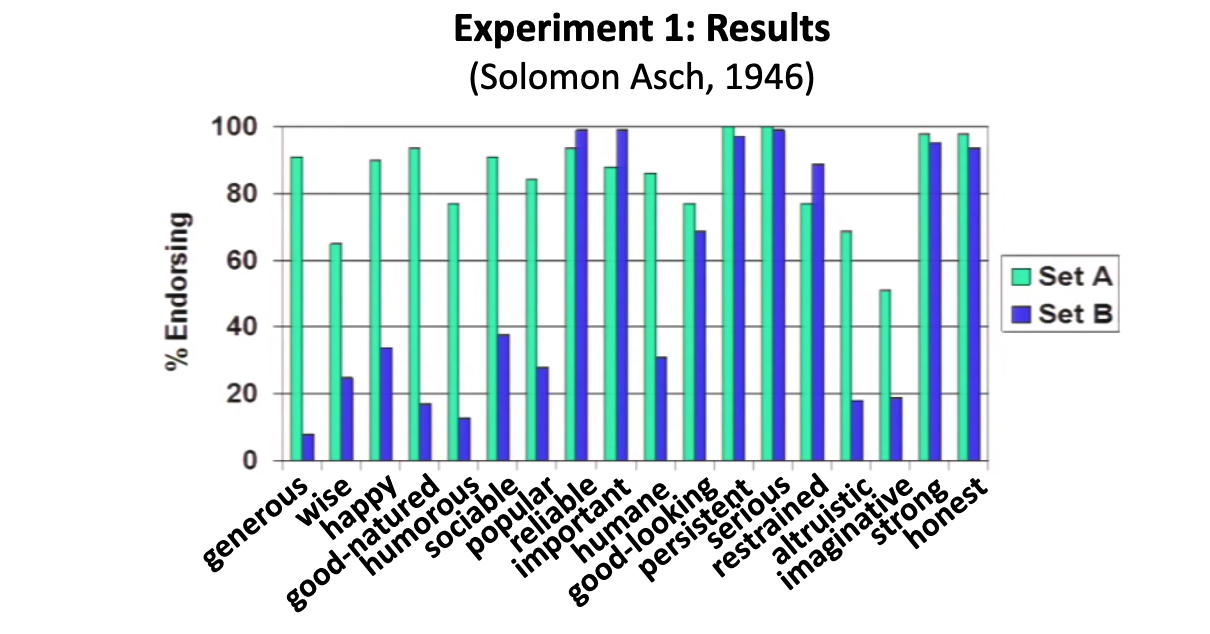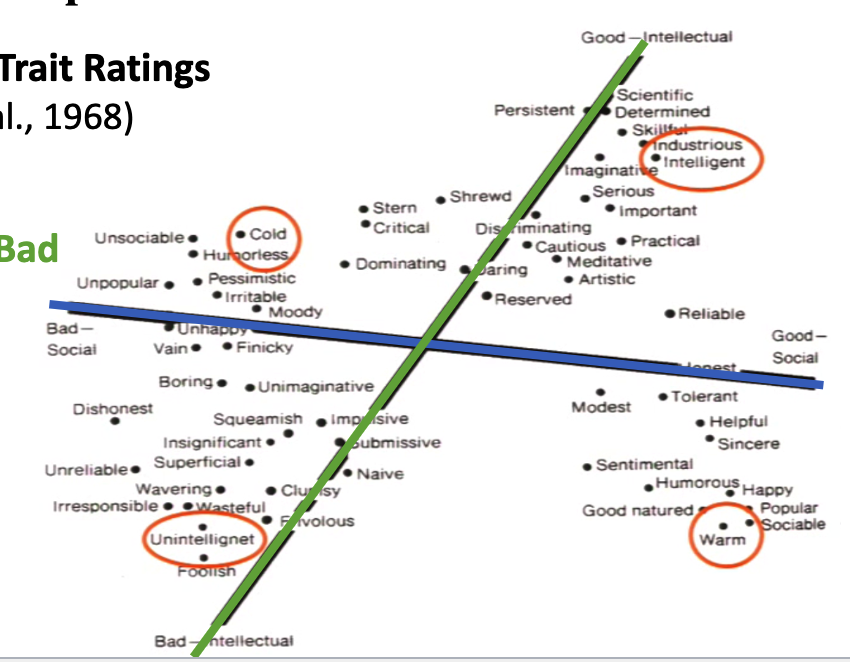
PSYC 137 Week 3
Social Perception II: Person Perception
Trait Perception: Unifying impression
Are all contents of a person (trait) perceptions equally important?
What’s a trait? Why focus on a trait?
relatively stable characteristics
such as personality (but still debated)
second most frequently used category
relatively unique to person perception
Person Perception as Impression Formation (Solomon Asch, 1946)
Stage 1: View A List of Traits Describing a Stranger
Stage 2: Provide Impressions of the Stranger
saw that both set A and set B results were different even though there was only one word different
Set A had the word “warm”
Set B had the word “cold”

Are all traits equally important?
they tried changing other traits, to see if they effect the overall impressions
their conclusion is that not all traits are equally important
warm and cold are more important than others
Central traits
Qualities that, When Changed, Alter the Entire Impression of a Person
Qualities that, When Changed, Alter the Meaning of Other Traits
Trait Perception: Searching for Central Traits
What makes a trait central? Julius Wishner, 1960
Participants (Students) Rated their instructors on each of the 53 traits
Researchers Computed the correlations between the 53 traits across
Central Traits are More Correlated with Other Traits
Given the High Correlations, Changing the Central Traits Will Change the Person’s Standing on Many Other Traits, Thus Changing the Overall Impression
What is the problem with this definition?
what’s the threshold for high or low correlation
any traits can become central traits
central traits will differ given different subsets of traits examined → select a more comprehensive set of traits is how you fix this problem
central traits will differ given different specific trait items used (synonyms) → factor analysis solved this problem
Factor analysis of trait ratings (Rosenberg et al., 1968)
Factors are not specific trait terms used
Factors are underlying constructs that drive the correlations among different trait Perceptions
Some colors are more correlated than others
why are the perceptions of these colors are more correlated?
all colors come from the three primary colors, R, G,B
these colors are influenced by a common color factor more than other color factors
he asked participants using a trait list to rate a person by the list
you can plot at the end the specific trait and find along which axes the trait varied the most
the Social Good-Bad (blue)
intellectually Good-Bad (green)

Trait Perception: Comprehensive Set To Find Central Traits
lexical approach
language models help sample traits that are most different
turn the abstract words into numbers for the computer
Social Cognition III: Trait Perception
Trait Perception From Faces
how people perceive others using words
how people perceive others based on information of the person
which facial features are central in impression formation?
what facial features matter?
eyes/ shape
mouth/ smiling or frowning
eyebrows/shape or position
structural resemblance to emotional expressions
Overgeneralization Theory (Leslie Zebrowitz, 2017)
recognizing emotional cues → survival (fight or flight) → anger cues → danger situation → threat → overgeneralize: resemblance to anger → threat
based on evolutionary pov, other facial features that may be important could be…
Babyfaceness
how might babyfaceness influence trait perception?
recognizing babies → survival of genes → weak, warm → overgeneralize: adults with babyface → weak, warm
Attractiveness
how might attractiveness influence trait perception?
attractive people are more desirable
Overgeneralization theory
recognizing fitness → survival of genes → mate, desire
overgeneralize: attractive people → fit → desirable
overgeneralize: attractiveness Halo Effect → more friendly, confident (Eagly, Ashmore, Makhijani, and Longo, 1991)
Familiarity
recognizing familiar people → kinship → safe, trust → overgeneralize: people looks familiar → trustworthy
Demographics (gender, age, race)
Facial structures
face Width-to-Height Ratio
face roundness, heartshapeness
cheekbone prominence
eye shape, eye size, nose shape, nose size, lip fullness
structural resemeblance to emotional expressions most important
the importance of other features depend on traits
Trait Perception From Body
Generate different stimuli using a computational model
Then they were asked to measure trait perception from the body
Factor analysis to understand which features of the body shift trait perception the most
Conclusion is that there are two body shape features that predict trait perception: weight and shapeliness
associations between body shapes and trait perceptions reflect stereotypes, not the truth!
Trait Perception From Context
Study: color intensity increases perceived extraversion and openness for zero-acquaintance judgments
generated stimuli: backgrounds with different color intensities
asked people to perceive the extraversion, openness, agreeableness, conscientiousness, and emotional stability
results: people thought that more saturated background = more open-minded and extrovert etc.
generated stimulus: clothes with different color intensities
same as before but whether more or less saturated clothing changes trait perception
results: more saturated color = more likely to be thought be open-minded, etc.
PSYC 137 Week 3
Social Perception II: Person Perception
Trait Perception: Unifying impression
Are all contents of a person (trait) perceptions equally important?
What’s a trait? Why focus on a trait?
relatively stable characteristics
such as personality (but still debated)
second most frequently used category
relatively unique to person perception
Person Perception as Impression Formation (Solomon Asch, 1946)
Stage 1: View A List of Traits Describing a Stranger
Stage 2: Provide Impressions of the Stranger
saw that both set A and set B results were different even though there was only one word different
Set A had the word “warm”
Set B had the word “cold”

Are all traits equally important?
they tried changing other traits, to see if they effect the overall impressions
their conclusion is that not all traits are equally important
warm and cold are more important than others
Central traits
Qualities that, When Changed, Alter the Entire Impression of a Person
Qualities that, When Changed, Alter the Meaning of Other Traits
Trait Perception: Searching for Central Traits
What makes a trait central? Julius Wishner, 1960
Participants (Students) Rated their instructors on each of the 53 traits
Researchers Computed the correlations between the 53 traits across
Central Traits are More Correlated with Other Traits
Given the High Correlations, Changing the Central Traits Will Change the Person’s Standing on Many Other Traits, Thus Changing the Overall Impression
What is the problem with this definition?
what’s the threshold for high or low correlation
any traits can become central traits
central traits will differ given different subsets of traits examined → select a more comprehensive set of traits is how you fix this problem
central traits will differ given different specific trait items used (synonyms) → factor analysis solved this problem
Factor analysis of trait ratings (Rosenberg et al., 1968)
Factors are not specific trait terms used
Factors are underlying constructs that drive the correlations among different trait Perceptions
Some colors are more correlated than others
why are the perceptions of these colors are more correlated?
all colors come from the three primary colors, R, G,B
these colors are influenced by a common color factor more than other color factors
he asked participants using a trait list to rate a person by the list
you can plot at the end the specific trait and find along which axes the trait varied the most
the Social Good-Bad (blue)
intellectually Good-Bad (green)

Trait Perception: Comprehensive Set To Find Central Traits
lexical approach
language models help sample traits that are most different
turn the abstract words into numbers for the computer
Social Cognition III: Trait Perception
Trait Perception From Faces
how people perceive others using words
how people perceive others based on information of the person
which facial features are central in impression formation?
what facial features matter?
eyes/ shape
mouth/ smiling or frowning
eyebrows/shape or position
structural resemblance to emotional expressions
Overgeneralization Theory (Leslie Zebrowitz, 2017)
recognizing emotional cues → survival (fight or flight) → anger cues → danger situation → threat → overgeneralize: resemblance to anger → threat
based on evolutionary pov, other facial features that may be important could be…
Babyfaceness
how might babyfaceness influence trait perception?
recognizing babies → survival of genes → weak, warm → overgeneralize: adults with babyface → weak, warm
Attractiveness
how might attractiveness influence trait perception?
attractive people are more desirable
Overgeneralization theory
recognizing fitness → survival of genes → mate, desire
overgeneralize: attractive people → fit → desirable
overgeneralize: attractiveness Halo Effect → more friendly, confident (Eagly, Ashmore, Makhijani, and Longo, 1991)
Familiarity
recognizing familiar people → kinship → safe, trust → overgeneralize: people looks familiar → trustworthy
Demographics (gender, age, race)
Facial structures
face Width-to-Height Ratio
face roundness, heartshapeness
cheekbone prominence
eye shape, eye size, nose shape, nose size, lip fullness
structural resemeblance to emotional expressions most important
the importance of other features depend on traits
Trait Perception From Body
Generate different stimuli using a computational model
Then they were asked to measure trait perception from the body
Factor analysis to understand which features of the body shift trait perception the most
Conclusion is that there are two body shape features that predict trait perception: weight and shapeliness
associations between body shapes and trait perceptions reflect stereotypes, not the truth!
Trait Perception From Context
Study: color intensity increases perceived extraversion and openness for zero-acquaintance judgments
generated stimuli: backgrounds with different color intensities
asked people to perceive the extraversion, openness, agreeableness, conscientiousness, and emotional stability
results: people thought that more saturated background = more open-minded and extrovert etc.
generated stimulus: clothes with different color intensities
same as before but whether more or less saturated clothing changes trait perception
results: more saturated color = more likely to be thought be open-minded, etc.